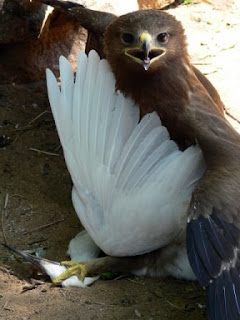Psycho is not exactly a decent name for a croc but that’s what I call our male Tomistoma. He never really got along with the female and now I’m trying to get him a new bigger female. May be… he likes big girls! ;)
There are 14 species of crocs here at Croc Bank; around 2200 individuals, and they truly are ‘individuals’. They are all so different; each with a unique personality. They all have their choices, likes and dislikes. Animals in captivity provide such great opportunities to dig deeper into their way of living and observe some really cool behavior. Croc Bank is thus one awesome place. With so many crocs around there’s always something happening; audible communications, gestures, displays, fights to name a few.
Feeding time is always fun. Fun for crocs, fun for us. Especially when you can see the otherwise ‘shy’ crocs so actively feeding/foraging. Most of the crocs are opportunistic feeders. They will eat what they can catch.
The Mugger was faster than the egret this time.
Gharials are different. They are specialist feeders, feeding almost exclusively on fish. They are built for catching fish, though I have documented one instance of a Gharial eating an egret. But that was one freak incident. They’re happier with fish on the menu. That’s why we are able to house the breeding stock of Batagur kachuga and some other turtles with Gharials. But this is not the only species tolerating turtles.
These three species; African Slender-snouted Crocodile Mecistops cataphractus (left), Tomistoma Tomistoma schlegelii (center) and the Gharial Gavialis gangeticus (right) are fairly big, the latter two being one of the largest. But they have never really harmed any of the Melanochelys trijuga (Indian Black Turtle) living (and breeding like rabbits in some!) in the same enclosure. Interestingly, they have one physical characteristic in common. Hmmm.. what could that be? The shape of the snout? Yes! They are all narrow snouted crocs. Gharials have a somewhat delicate snout built to catch fish. So delicate that it may break in a fight! The Slender-snouted Croc and Tomistoma are not restricted to fish only. Small mammals, birds, reptiles (except turtles) are part of their diet, even monkeys in case of Tomistoma! The teeth formation in these species is interesting too. Most of the teeth are sharpish and narrowish, built for ‘catching’, not many for crushing. Same with the jaw muscles. This could probably explain why they are not into turtles. But in spite of this explanation, who would want to challenge the mighty Tomistoma, that too Psycho?!?
I hope these little pirates don’t push their luck too far!























